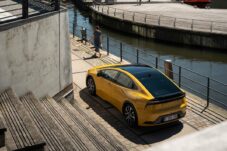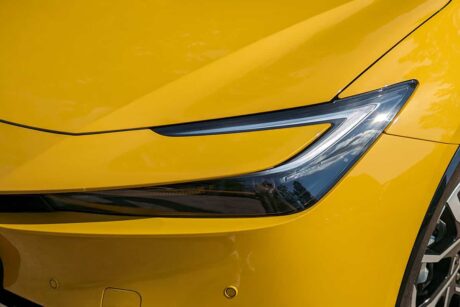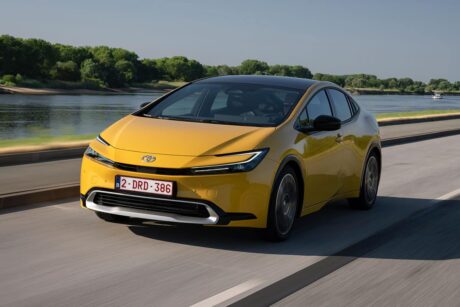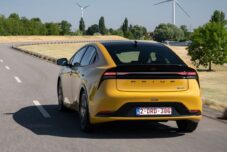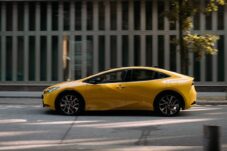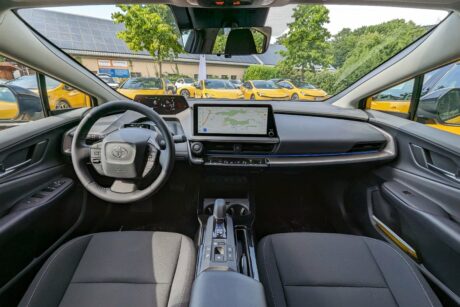-20% on the entire catalog today
Free shipping starting from $18
- Back to home
- You are here : Blog News Toyota Prius PHEV test: The incredible performance of my Toyota car!
Toyota Prius PHEV test: The incredible performance of my Toyota car!
Published by The team in News the 29/06/2023 at 18:15

The Toyota Prius is a true legend in automotive history. Always pragmatic with its simple and reliable hybrid mechanics, it pushes even further with its exclusive new generation rechargeable hybrid (PHEV).
In 1995, Toyota created a true revolution with the concept of the Prius, thus laying the foundations for a major chapter in automotive history. Two years later, the production Prius appeared, introducing the famous HSD system. This simple, economical and robust solution quickly became a resounding success and has nothing to prove today. It even aroused the interest of many other manufacturers, such as Ford, which acquired patents for its Kuga model, for example. As the first major hybrid car, this sedan, which everyone tends to forget (yet it's not so unsightly, is it?), gave birth to more than 23 million Toyota hybrid vehicles in the world to date.
Today, it is the turn of the fifth generation to make its appearance. This sedan retains the characteristics of the family, with a touch of exoticism that ultimately allows it to appeal to a wider audience, even if its design is not as original. While it is available elsewhere in the world with a simple hybrid engine (as in the United States where this technology is widespread), it only opts for a plug-in hybrid configuration here. Toyota is taking a cautious approach to electric mobility, but the Japanese brand is slowly preparing for an energy transition in Europe. Thus, the Prius is seen as an effective way to prepare drivers for all-electric driving. How ? By offering two cars in one,
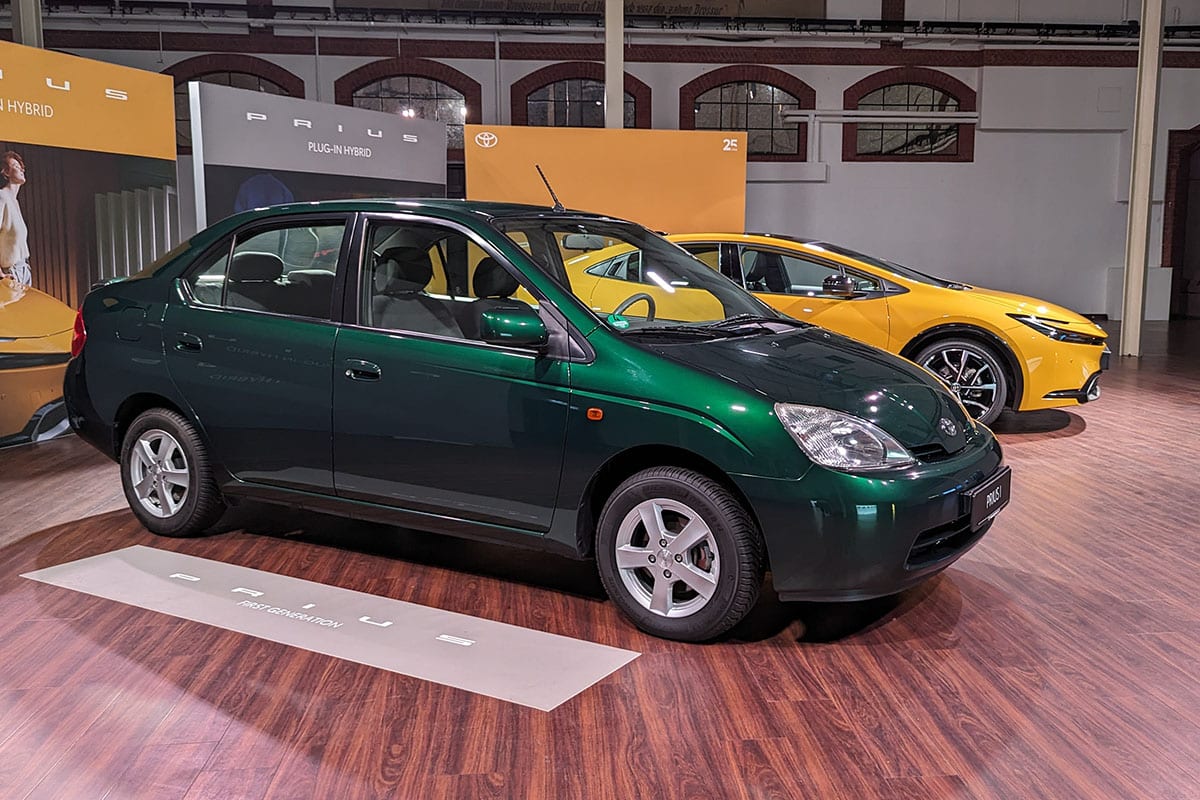
The Toyota Prius PHEV benefits from a significant increase in power.
The concept of plug-in hybrid cars is applied here, but the philosophy is slightly different, particularly with regard to the management of the powertrain. The car operates as an extended HSD system, offering hybrid modes by default, while offering far greater range than other variants. It can be considered an improved version (HEV+) or an advanced version (h+) of the Lexus PHEVs. Under the hood, we find the M20A-FXS 4-cylinder engine from the Dynamic Force family, developing 152 hp and 190 Nm of torque. Still naturally aspirated and operating according to the Atkinson cycle (prioritizing efficiency rather than performance), it is associated with an electric machine of 163 hp and a torque of 208 Nm. The assembly delivers a combined power of 223 hp,
The Panasonic battery with a gross capacity of 13.6 kWh powers the electric drive train of this car. It operates at a voltage of 266 V. Compared to the previous Toyota Prius Prime, this new generation benefits from a notable improvement, with an increase of 4.8 kWh in capacity. Although the Japanese brand does not reveal the exact useful capacity of this battery, our various measurements estimate that it is around 11 kWh.
The Toyota Prius PHEV offers exceptional range in its class.
According to the WLTP standard, it promises a range of 72 km (86 km with 17-inch rims). During our test, we covered just over 66 km in mixed driving conditions. This performance is remarkable for a sedan that is not so compact (Toyota classifies it in the C segment) and it far exceeds that which can be obtained with a Peugeot 308 or a Skoda Octavia iV. This clearly illustrates the advantages of a car designed as an electric vehicle.
This is demonstrated by the integration of a heat pump with the aim of guaranteeing the thermal comfort of the users by using the EV mode during the winter. This high-end feature is still available as an option for some electric models, although other plug-in hybrids such as the Hyundai/Kia or the MG EHS don't even offer additional heating. The development teams have revealed that the brand does not want to compromise in order to emphasize the all-electric nature of the Prius. Paradoxically, the on-board charger is limited to just 3.5kW (allowing a full charge in 4 hours), while other competitors offer a 7.4kW system.
The fuel consumption of the Toyota Prius PHEV in hybrid mode is similar to that of the Corolla.
The system can reserve up to 5% charge before attempting to recover it. Although the charging base when the battery is empty has not been specified, the operation remains the same in this case. We can only note a slight overconsumption due to a lower reserve than in normal times. However, this should not confuse users. Once the battery is empty, the average consumption measured is 4.8 l/100 km. Our short highway jaunts lead us to expect fuel consumption of less than 7.0 l/100 km, but this needs to be confirmed.
Anyway, the American homologation sheets are clear: in the United States, the Toyota Prius PHEV has an average consumption of 5.0 l/100 km, without taking into account the utility factor. This value is important according to the European homologation system, which allows the sedan to display a consumption of only 0.7 l/100 km and CO2 emissions of 16 g/km (0.5 l/100 km and 11 g/km with 17-inch rims), neglecting the WLTP protocol which is absurd for plug-in hybrids in Europe. In summary, we are not going to restart the debate. However, what should be remembered is that the Prius PHEV should consume as much as a Corolla Touring Hybrid when its battery is empty. This is not surprising since these two models only differ by a hundred kilos. It should be noted that there is an HEV Auto mode which alternates between HEV and EV operating modes based on navigation information. Consumption will be even lower, but the battery charge will depend on the types of roads taken.
Improved chassis and performance
Thanks to its TNGA-C 2.0 platform, the latest generation of hybrid powertrain has been integrated into the Toyota Prius PHEV, also offering new opportunities for chassis engineers. In order to reduce the center of gravity, the battery has been moved under the rear seats, previously located in the trunk floor. The structure has been reinforced for more lightness and rigidity, while the tracks have been widened. The driving of the car is responsive and precise thanks to a steering wheel which allows precise control of the movements of the front axle and the responsiveness of the chassis. Although we haven't pushed the Toyota Prius PHEV to its limits, its behavior is appealing when called upon in evasive or trajectory-correcting maneuvers. Like many current cars,
Driving becomes considerably more pleasant with this new hybrid tandem, which is always responsive. EV mode, available up to 135 km/h, is not suitable for highway use, as the battery drains quickly in these conditions. Also, while performance is adequate overall, it doesn't allow for tight cornering: we recorded a time of 9.7 seconds to go from 80 to 120 km/h in all-electric mode, while that the sedan only needs 5.3 seconds in hybrid mode. It accelerates as quickly as a Skoda Octavia Combi PHEV or a hybrid DS4.
Novice drivers will always be surprised by the powerful acceleration generated by the planetary transmission. Regulars of this technology will notice the improvements made in terms of management and soundproofing. Apart from the frank accelerations, the passage from one mode to another is even imperceptible. Additionally, the brake pedal provides a more natural feel. However, it is unfortunate that the default B mode is not powerful enough. You will have to navigate through the menus to adjust it, which is not practical in terms of ergonomics.
A lack of practicality is felt.
Inside, the architecture adopts a more conventional appearance and the presentation is less exotic than before. For the first time, the instrumentation is moved in front of the driver (previously located behind the windshield). However, it remains at a certain distance and it is necessary to squint to read the information displayed on the 7-inch screen. In addition, the top of the steering wheel partially hides the display, thus forcing the driver to lower it and adopt an unusual driving position. In the center, another screen is dedicated to the infotainment system, while a digital rearview mirror is also present. It should be noted that its camera is placed in height and the zoom does not allow to correctly assess the distances.
Better ergonomics are guaranteed by less eccentricity: it is no longer necessary to bend over to switch on the heated seats, as the controls are easily accessible within reach. However, despite the efforts made, this fails to compete with the quality of the materials used inside the vehicle. This is particularly the case with the surface of the dashboard, which is made of extremely fragile grainy plastic: a simple touch to satisfy our dust-related concerns left a mark.
Although this new generation has been shortened by 4.6 cm, the wheelbase has been increased by 5.0 cm. This greatly benefits the knee room in the back. However, if the passengers sit lower, the height under the roof is not optimal for tall people. In addition, although the battery is no longer located in the trunk floor, it remains high. Space is limited under the shelf, which reduces the volume of the trunk to 284 liters, which is as much as in a Yaris.
My Toyota is amazing, but its price is not.
The undisputed queen of hybrid cars is back, but this time she has chosen to offer only plug-in hybrid mechanics here, while maintaining her mechanical simplicity on the other side of the Atlantic where she is a institution. And it would be wrong not to, because despite being only 162 kg overweight compared to the hybrid version (according to the American technical specifications that we used for the comparison), it displays a similar consumption, at least equivalent to that of a Corolla Touring, as we found.
As far as fully electric mobility is concerned, its autonomy is one of the most generous in its category. Toyota claims that this is the result of development conducted as for an electric car, and the brand has put the means to achieve this: in addition to the heat pump, there is for example a solar panel on the roof which allows to gain up to 70 km of autonomy (almost a full tank) per week of sunshine. However, it's a shame that this sedan, which aims to be the technological flagship of the range, only has a 3.5 kW on-board charger, which is quite limited. A more powerful charging unit would certainly encourage users to charge their vehicle more often in order to reduce their budget and, mathematically, CO2 emissions.
The new Toyota Prius PHEV is available from €43,900 with the Dynamic finish, which offers the best energy performance. The top-of-the-range Lounge finish reaches €51,500. This Japanese sedan, which introduces the manufacturer's latest technologies in hybrid mobility, therefore demands a high price for its status. However, it also benefits from the absence of direct competition, because the Skoda Octavia, its only real rival, is no longer available in the brand's catalog!
Post a comment
Order safely
Quick delivery
By your side 7 days a week !
14 days to change your mind
Subscribe to the newsletter







